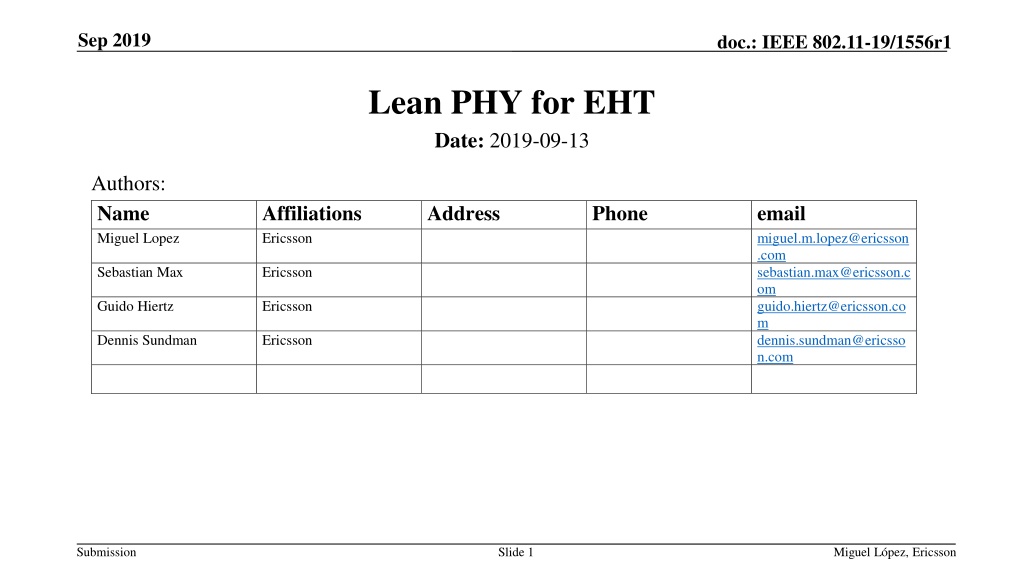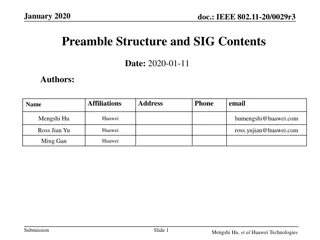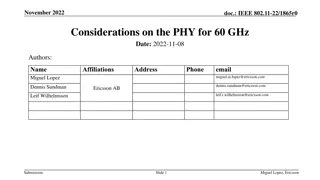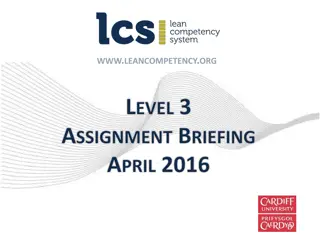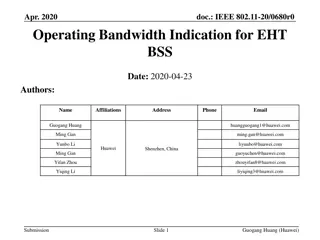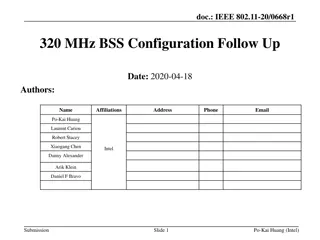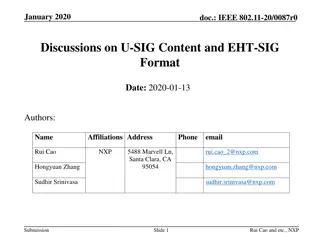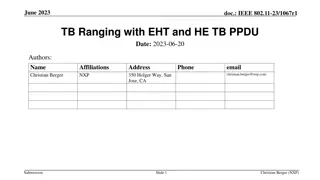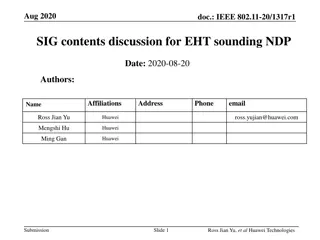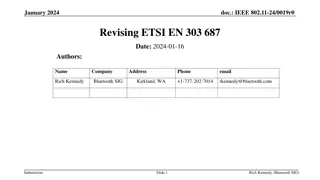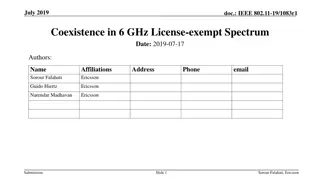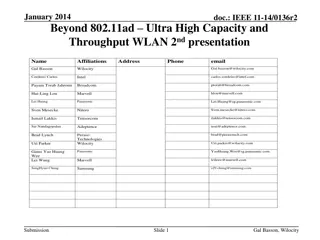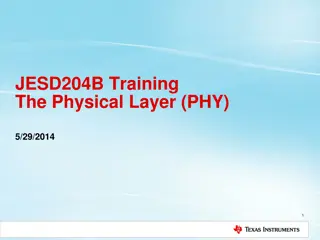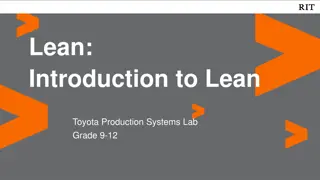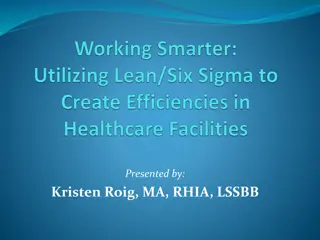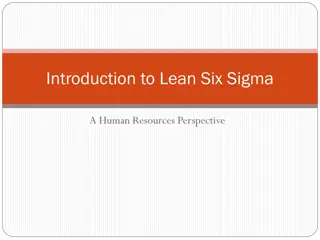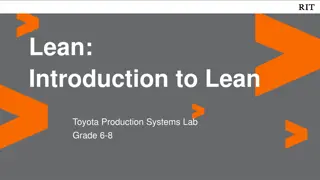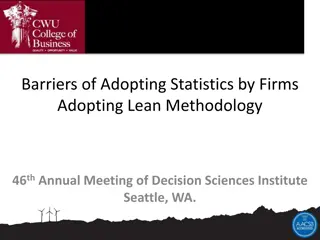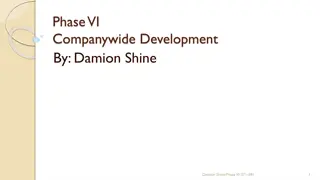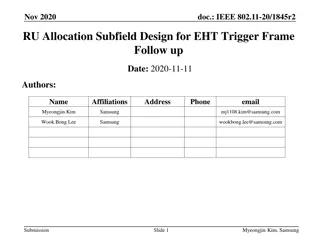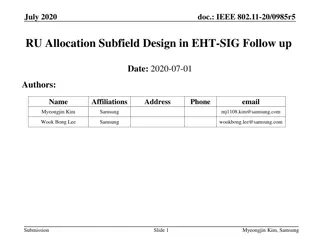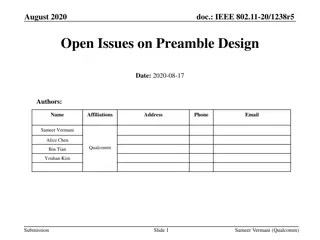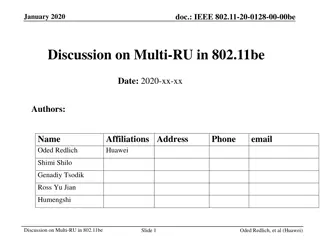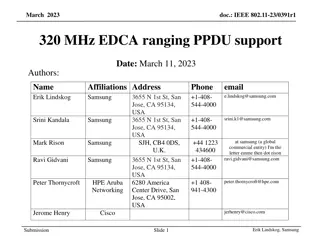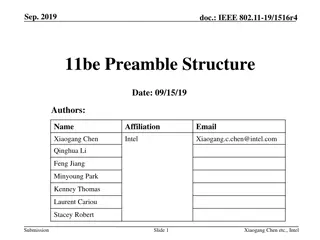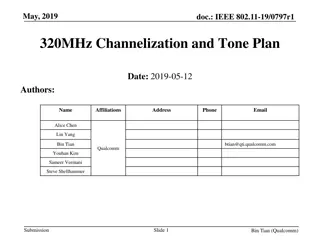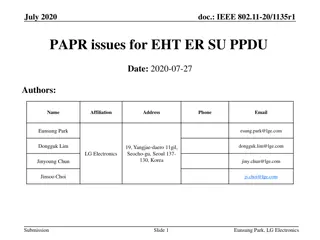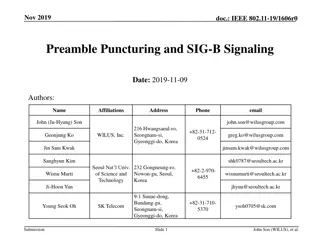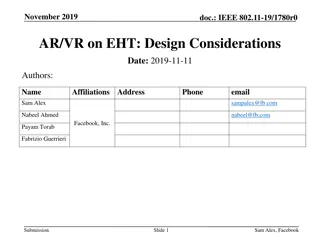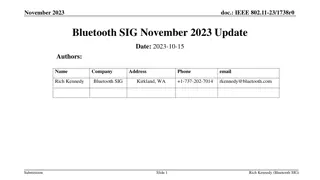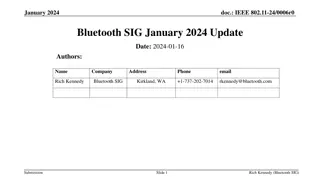Relevance of Lean PHY for EHT in 6 GHz
Discussing the importance of a Lean PHY for EHT in 6 GHz to improve spectrum efficiency and reduce overhead. Introducing the Low Throughput PHY as a potential solution, highlighting its benefits compared to existing options like 802.11a. Measurement results show the impact and potential for enhancing radio resource utilization in various use cases.
Download Presentation

Please find below an Image/Link to download the presentation.
The content on the website is provided AS IS for your information and personal use only. It may not be sold, licensed, or shared on other websites without obtaining consent from the author. Download presentation by click this link. If you encounter any issues during the download, it is possible that the publisher has removed the file from their server.
E N D
Presentation Transcript
Sep 2019 doc.: IEEE 802.11-19/1556r1 Lean PHY for EHT Date: 2019-09-13 Authors: Name Miguel Lopez Affiliations Ericsson Address Phone email miguel.m.lopez@ericsson .com sebastian.max@ericsson.c om guido.hiertz@ericsson.co m dennis.sundman@ericsso n.com Sebastian Max Ericsson Guido Hiertz Ericsson Dennis Sundman Ericsson Submission Slide 1 Miguel L pez, Ericsson
Sep 2019 doc.: IEEE 802.11-19/1556r1 Abstract This contribution discusses the relevance of a so-called Lean PHY for EHT in 6 GHz, which is an efficient, low overhead PHY intended for management, control and short data PPDUs. The potential losses in spectrum efficiency associated with inefficient PHYs are illustrated by means of measurements in 5 GHz, and it is pointed out that such inefficiencies are undesirable and should be avoided in 6 GHz. We also discuss the legacy preamble and argue that it is wasteful. Submission Slide 2 Miguel L pez, Ericsson
Sep 2019 doc.: IEEE 802.11-19/1556r1 Recap The contribution [1] highlighted the need for a low overhead PHY for EHT in 6 GHz, fulfilling a role similar to the 802.11a PHY in 5 GHz, A PHY for management, control, and short data frames is needed. [1] also explains why using 802.11a in 6 GHz is undesirable, and proposes an alternative PHY called Low Throughput PHY (LT PHY) [1] states that the LT PHY should be mandatory in 6 GHz and forbidden in 2.4 GHz and 5 GHz [1] describes in some detail the LT PHY. It utilizes the 802.11ac PHY for the data portion of the PPDU and has a very short preamble [2] provides a comparison among 802.11a, HE and LT PHYs for short PPDUs. It shows the impact and usefulness of short preambles LT PHY results in a substantial reduction of airtime utilization [3] shows that small frame size dominates in typical WLAN deployments Slide 3 Submission Miguel L pez, Ericsson
Sep 2019 doc.: IEEE 802.11-19/1556r1 Introduction Measurements were performed in order to gauge the utilization of the 802.11a PHY and its impact on radio resource utilization Network traces were recorded using a network sniffer Although the actual usage of the 802.11a PHY is vendor and use case specific, the examples in the following 4 slides capture common, relevant use cases of 802.11 and illustrate why it is important to have a low overhead PHY in 6 GHz Submission Slide 4 Miguel L pez, Ericsson
Sep 2019 doc.: IEEE 802.11-19/1556r1 Measurement setup Experiment 1: Home environment (Germany) Streaming video from IEEE 802.11ac AP to IEEE 802.11ac STA Channel 42 (80 MHz @ 5.21 GHz) Experiment 2: Large meeting (IEEE 802.11 plenary) IEEE 802.11ac AP(s), many associated STAs Channel 44 (20 MHz @ 5.22 GHz) Measurement Device MacBook Pro 2017, set to promiscuous mode, all (successfully received) frames on a fixed channel are analyzed Count number of frames Frame type / subtype Payload size, rate Submission Slide 5 Miguel L pez, Ericsson
Sep 2019 doc.: IEEE 802.11-19/1556r1 Measurement results: home environment 170806 received frames 25847 Data 99931 Control 45028 Management Observation: even though the link supports data rates of several hundreds of Mb/s, a significant fraction of the PPDUs have data rates from 6 Mb/s to 24 Mb/s Submission Slide 6 Miguel L pez, Ericsson
Sep 2019 doc.: IEEE 802.11-19/1556r1 Measurement results: Large meeting 14690 received frames 5637 Data 4909 Control 4144 Management Observations: Control and management frames are a substantial part of the traffic and have data rates from 6 Mb/s to 24 Mb/s. The 6 Mb/s rate is often used for data Submission Slide 7 Miguel L pez, Ericsson
Sep 2019 doc.: IEEE 802.11-19/1556r1 Radio resource consumption We estimate the consumption of radio resources in the time-frequency plane as follows. rate R [bits/s] B [Hz] RR consumption = B Nb/R [Hz s] Nb[bits] Experiment 1 (home environment): 802.11a PHY RR consumption = 596.2 106Hz s QoS data (VHT) PHY RR consumption = 12.7 106Hz s RR consumption of management/control (802.11a) is 47 times that of VHT Submission Slide 8 Miguel L pez, Ericsson
Sep 2019 doc.: IEEE 802.11-19/1556r1 Discussion The use of an inefficient PHY for management/control/short data PPDUs could lead to a very high radio resource consumption when compared to EHT data PPDUs In certain scenarios, the spectrum efficiency improvements stemming from EHT become irrelevant because of said inefficient PHY The use of an inefficient PHY for management/control/short data PPDUs leads to very high radio resource consumption when compared to EHT data PPDUs It is desirable to define a Lean PHY for management, control and short data PPDUs The LT PHY introduced in [1] is an example of Lean PHY. Submission Slide 9 Miguel L pez, Ericsson
Sep 2019 doc.: IEEE 802.11-19/1556r1 Lean PHY for 6 GHz Reference [1] lists some desirable properties of the LT PHY for 6 GHz (e.g. it is not compatible with legacy STAs, a PPDU could have very large bandwidth, etc.) In addition, we propose the following for the Lean PHY The data part in a Lean PHY PPDU should use the HE/EHT OFDM numerology (i.e. 78.125 kHz subcarrier spacing, tone plans from HE/EHT etc.) HE utilizes the available radio resources more efficiently than VHT. The PHY preamble should be as short as practically possible Submission Slide 10 Miguel L pez, Ericsson
Sep 2019 doc.: IEEE 802.11-19/1556r1 Inefficiency of the legacy preamble in 6 GHz Consider a legacy preamble in a 320 MHz PPDU, comprising an L-STF, L- LTF, L-SIG, RL-SIG and pre-SIG It carries a payload of ~52 bits It consumes a non-neglible amount of radio resources: 8.96 103?? ? As a comparison, using an efficient PHY like MCS-11 from 802.11ax and 16SS, the same time-frequency resources could support the transmission of ~1 Mb of data. The legacy preamble is highly inefficient and wasteful The legacy preamble could be removed from some EHT PPDUs in 6 GHz without compromising compatibility with 802.11ax STAs operating in 6 GHz For example during cascaded operation within a TXOP, since the frames exchanged between the AP and STAs are protected Slide 11 Submission Miguel L pez, Ericsson
Sep 2019 doc.: IEEE 802.11-19/1556r1 Straw poll #1 Do you agree that 802.11be should standardize a Lean PHY intended for management or control or short data PPDUs in 6 GHz? Y/N/A Submission Slide 12 Miguel L pez, Ericsson
Sep 2019 doc.: IEEE 802.11-19/1556r1 Straw poll #2 Do you agree that the legacy preamble may be omitted from some EHT PPDUs in 6 GHz? (The conditions that allow the removal of the legacy preamble are TBD, and the preamble format is also TBD.) Y/N/A Submission Slide 13 Miguel L pez, Ericsson
Sep 2019 doc.: IEEE 802.11-19/1556r1 References [1] B. Hart et al., EHT Candidate Technology Review https://mentor.ieee.org/802.11/dcn/18/11-18-1549-00-0eht-candidate- technology-review.pptx, Sep 2018 [2] B. Hart et al, 6 GHz Principles https://mentor.ieee.org/802.11/dcn/18/11- 18-1897-00-00ax-6ghz-principles.pptx, Nov 2018 [3] C. Lukaszewski and L. Li, "In Situ Frame Size Measurements" https://mentor.ieee.org/802.11/dcn/15/11-15-0343-01, Mar 2015 Submission Slide 14 Miguel L pez, Ericsson
